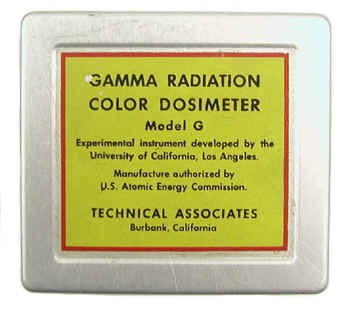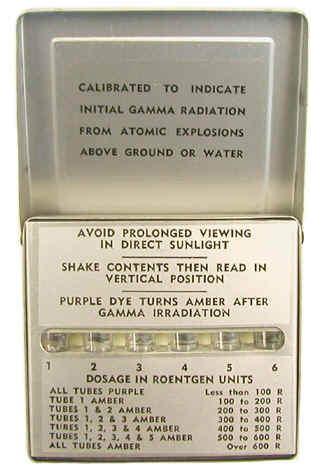Technical Associates Model G Color Dosimeter (ca. 1950s)

As is stated on the case, the Model G color dosimeter, is an “experimental instrument developed by the University of California, Los Angeles [UCLA].” It was manufactured by Technical Associates under an Atomic Energy Commission contract.
It is likely that this device served as the predecessor to the model EIR3 color dosimeter, seen in the RADIAC section of the collection. The main difference is that the latter has five liquid filled tubes whereas this dosimeter employs six. Learn more about the RADIAC dosimeter.
The dosimeter, developed by George V. Taplin, Clayton Douglas, and B. Sanchezet, was described in “A Sensitive Colorimetric Method for Radiation Dosimetry” (UCLA-118). The solution consists of alcohol-free chloroform and the dye brome-creosol purple. When the chloroform absorbs radiation energy, hydrochloric acid is produced which changes the dye color from purple to yellow. Sodium hydroxide is added to adjust the sensitivity.

The February 28, 1950 issue of the Los Angeles Times reported:
"Designed specifically to measure large doses of gamma and X-rays scattered by an atomic explosion, a new radiation indicator has been perfected by UCLA researchers, it was announced yesterday."
The following quotes from 1952 (Humboldt Standard, June 26, 1952) clearly refer to this dosimeter even though some of the details are a little off:
"A small metal box known as a colorimetric dosimeter that can determine your chance of life or death in an atomic attack, is being developed by the University of California at Los Angeles, it was revealed here."
"The two-inch black box is a chemical radiation detector and contains three tubes [rather than the six in this device] of purple liquid. Each tube is set to absorb a certain amount of radiation without change."
"After that point if one tube turns yellow - - you'll survive if given blood plasma and treatment. If two tubes turn yellow - - there's a slightly less than 50 percent chance you'll survive. If all three tubes turn yellow - - 99 chances out of 100 you'll be dead within six weeks."
"Development of the device is being supervised by Dr. Stafford Warren, Dean of the UCLA Medical School and California's official radiological expert."
"State civil defense officials said every Californian may someday wear one around his neck like an army dog-tag."
"Each box would be riveted shut to prevent trading or purchasing of dosimeters. Name, address and blood type would be stamped into each box."
"The box would be opened only at a casualty station after an atomic bombing and medical corpsmen would be able to determine immediately to what degree the person had been exposed to radioactivity and the chances for saving the victim."
"Dr. Warren said before the boxes become acceptable for public use the federal bureau of standards must give them approval and the $2.50 per unit cost must be brought down to 25 or 50 cents."
"The purple liquid contained in the box is potassium hydroxide, chloroform and a special litmus-type dye. The tubes are made of a special pyrex to prevent radiation from minerals in the glass itself."
"When enough injurious gamma rays penetrate the liquid, part of the potassium compound changes structure. It combines with the chloroform to produce hydrochloric acid which turns the dye from purple to yellow."
Size: 1 5/8” x 2.5” x 0.5”
References
- Z. Morgan, unpublished manuscript, prepublication copy of "Health Control and Nuclear Research" 1952.
- Wane Sargent. Colorimetric Dosimeter Will be Used to Determine Radiation. Humboldt Standard, June 26, 1952.
